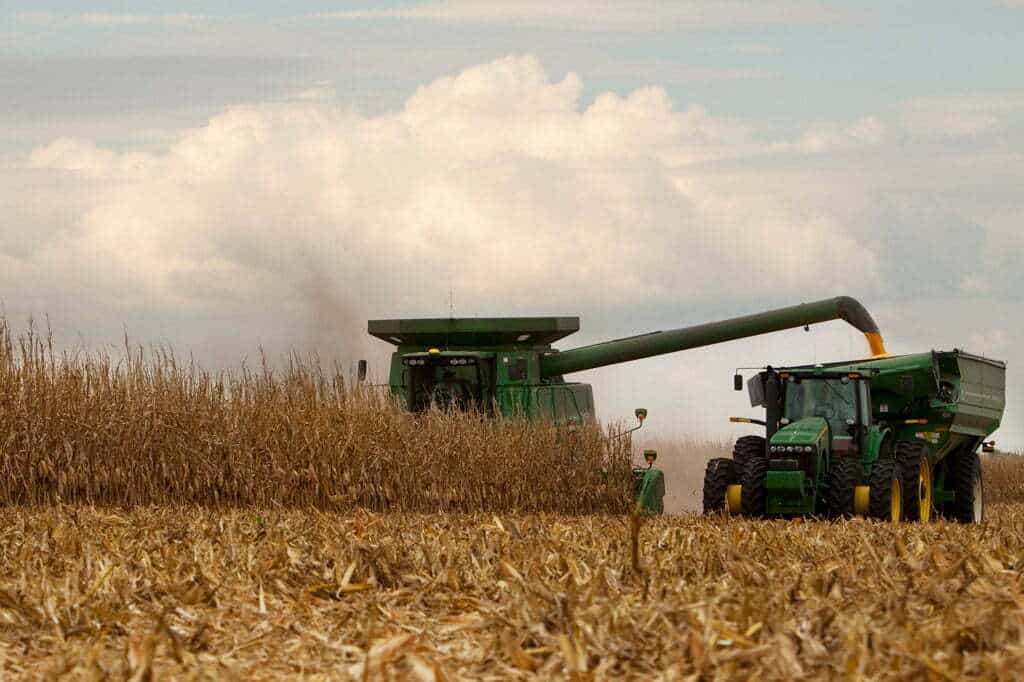Growing Nebraska Corn – PAST AND PRESENT
Each year, Nebraska farmers produce well over one billion bushels of high-quality corn. Nebraska is the nation’s third largest corn producer, behind only Iowa and Illinois.
We’re also second in ethanol production and distillers grain and first in cattle feed. Irrigation is one reason Nebraska consistently produces high volumes of corn. Nebraska has more irrigated corn acres than any other state, thanks in large part to the Ogallala Aquifer—a large underground water supply that lies beneath much of the state.
Drive across Nebraska during the summer and fall and you’ll see miles and miles of corn fields. But did you know that more than 99 percent of that corn is “field corn” and won’t directly end up on your plate for dinner or popped with a little butter and salt for a night at the movies? The other 1% of corn grown represents seven different types of corn.
Here are just a few of types of corn grown in Nebraska!

field corn VS. sweet CORN – WHAT’s THE DIFFERENCE?
Field corn is the classic big ears of yellow dented corn you see dried and harvested in the fall. In fact, it’s sometime called “dent corn” because of the distinctive dent that forms on the kernel as the corn dries. Field corn is grown until it is hard and dry, and then is harvested in the fall to be fed to livestock, processed into ethanol and exported domestically around the world.
Field corn has dozens of uses, but it is most commonly fed to animals or used to make renewable fuels like ethanol to power our cars and trucks. But only part of the kernel is used for ethanol (the starch), the rest of the kernel, including the protein and fat, are then used to make another popular animal feed known as distillers grains.
People don’t eat field corn directly from the field because it’s hard and certainly not sweet. Instead, field corn must go through a mill and be converted to food products and ingredients like corn syrup, corn flakes, yellow corn chips, corn starch or corn flour.
While 99 percent of the corn grown in Nebraska is field corn, there are dozens and dozens (and dozens) of varieties available for farmers to plant. Some have a shorter growing season from planting to maturity, and some are longer. Some handle certain soils better than others, and many have ways to protect themselves from insects and disease.
Sweet corn is what you’re eating when you have canned corn, corn-on-the-cob or frozen corn. This corn is bred for its plump, juicy kernels that include higher levels of natural sugars and a sweet flavor. While field corn is harvested when mature and dry to make transport and storage easy, sweet corn is harvested early when the kernels are young, moist and at peak flavor.
Specialty Corn
Popcorn contains a small amount of water. When the kernel heats up in the microwave, air popper or on the stove, the water expands until the kernel bursts open to create a light, delicious snack! Americans consume 16 billion quarts of popped popcorn annually – that’s 51 quarts per every man, woman and child!
Only about 220,000 acres of popcorn are grown each year in the United States, and Nebraska is the number-one producer in the country, harvesting some 300 million pounds of popcorn on roughly 67,000 acres.
White corn features a harder than normal starch is used in corn chips, tortillas and other popular food products. Nebraska is one of the top producers of white corn in the United States, with farmers here growing white corn for food and other companies across the country and even some foreign countries.
Some types of corn have been designed to include high levels of starch. This high-starch corn is perfect for ethanol production because ethanol is made from the starch, leaving the other parts of the kernel for distillers grains, a nutrient-rich feed for livestock.
Other white corn is bred to have high amounts of oil in its kernels. This high-oil corn is great for certain types of food processing or animal feed.
Waxy corn is used to thicken foods and make adhesives, while high-lysine corn provides valuable nutrients to certain types of animals, like pigs. Corn Nuts, a popular snack food, are made from floury corn with large kernels.
Nebraska’s Golden Triangle
How Corn is Used for Food and Fuel
This prime agricultural region means corn farmers have solid yields of corn for its markets: ethanol and livestock. The two dozen ethanol plants across the state then provide renewable fuel and feed ingredients for the livestock industry.
In turn, the cattle sector provides high-quality, corn-fed beef to people throughout the country and around the world. In essence, Nebraska’s Golden Triangle increases the value of corn via renewable biofuel, distillers grains and meat production all within Nebraska’s borders, providing an incredible economic engine for the state.
By using more Nebraska corn in Nebraska, we’re capturing more of the corn’s value right here in the state. That’s good for the state’s economy, rural communities and Nebraska corn farmers.
Growing and Harvesting Corn in Nebraska
Nebraska, like many Midwestern states that make up the “Corn Belt,” is well-suited for corn production.
Our average temperatures allow corn to flourish, and rainfall is plentiful in many parts of the state. Unique to Nebraska corn production, however, is the ability to supplement that rainfall when needed with irrigation water thanks to the plentiful water supply from the Ogallala Aquifer and reservoirs that capture water from snow-melt and rains as far west as the Rockies.
While approximately 70 percent of the corn produced in Nebraska receives some water from irrigation at some point in the growing season (this figure is less than 14 percent nationally), water is only applied when needed, depending on what Mother Nature provides via rainfall.
Nebraska’s average annual rainfall:
- East: 30 inches (76.2 centimeters)
- West: 18 inches (45.7 centimeters)
Farmers have become much more sophisticated in their use of water, changing how water is applied to the land and by taking advantage of technology like watermark sensors and evapotranspiration gauges, as well as research from the University of Nebraska and elsewhere. This has dramatically reduced the use of water on those acres that are irrigated – and improvements continue.
When Is Corn Planted?
On average, corn in Nebraska is planted anywhere from April 15 to June 5, although a majority of the crop is planted between April 25 and May 20.
When Is Corn Harvested?
Harvest dates range from September 10 to November 25 – although a majority of acres are harvested between September 30 and October 30. Some years, of course, harvest can stretch well beyond those dates.
Nebraska Corn Production History
| Year | Total Production | Bushels Per Acre Average |
|---|---|---|
| 1900 | 191,100,000 | 26 |
| 1920 | 242,891,000 | 33 |
| 1940 | 95,489,000 | 21 |
| 1960 | 333,438,000 | 51 |
| 1980 | 603,500,000 | 85 |
| 2000 | 1,014,300,000 | 126 |
| 2005 | 1,270,500,000 | 154 |
| 2010 | 1,469,100,000 | 166 |
| 2015 | 1,692,750,000 | 185 |
| 2020 | 1,790,090,000 | 181 |
| 2021 | 1,854,640,000 | 194 |
| 2022 | 1,455,300,000 | 165 |
| 2023 | 1,729,000,000 | 182 |
| 2024 | 1,802,920,000 | 188 |

The history of corn: Nebraska’s Rich Agricultural History
Corn has been a part of the region’s history for more than a 1000 years, long before Nebraska existed as a state. The crop was cultivated from its birthplace in Mesoamerica all the way north into what is now Canada, and from coast to coast. Humans and plants brilliantly adapted one to another; humans crafting their culture and calendar to meet the needs of corn crop and corn producing in return an essential food and feedstuff.
Native peoples began intensive corn horticulture in what is now Nebraska about 1,000 years ago, particularly along the southern and eastern regions rich with rivers and streams. Along with beans and squash, corn sustained tribal growth for long periods. By the early 1700s, tribes such as the Omaha, Pawnee, and Oto were living in villages of a thousand or more people. Here, they would raise crops that could yield around 30 bushels an acre.
With the opening of the Nebraska Territory in 1854, Euro-American farmers with their own corn cultures came west to find land of their own. They, too, learned that eastern and southern Nebraska was good corn country. They also learned that the different climate, rainfall, soil, weeds, and pests required different seeds and farming techniques. Trial and error along with knowledge produced and disseminated by the scientific community encouraged the growth of corn agriculture. By the late 1870s, corn crops were plentiful in Nebraska.
More corn produced by fewer people led to crop abundance that drove prices down, urging a demand for new value-added products to consume the surplus. Corn proved to be an excellent animal feed, particularly for beef, and by the mid 1880s Nebraska was a leader in livestock feeding. By the early 20th century, corn farmers and entrepreneurs alike invested in finding more uses for corn. As early as 1910, people looked to corn-based alcohol to replace kerosene in lamps and creatively, to serve as a motor fuel: ethanol.
Thank you to the Nebraska Historical Society for providing historical content.
Family Farms Continue to Grow and Innovate
As corn continues to grow, so does the sustaining innovation used to raise it. Many of Nebraska’s family farms got their start as part of the Homestead Act of 1862. Learn how they’ve continued to thrive as stewards of Nebraska corn.


